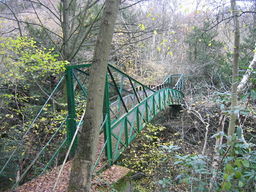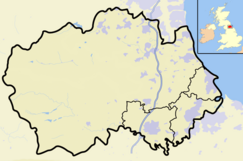Castle Eden Dene
| Castle Eden Dene | |
|
Site of Special Scientific Interest National Nature Reserve |
|
|
Gunners Pool Bridge in Castle Eden Dene
|
|
| Country | England |
|---|---|
| Region | North East |
| District | Easington |
| Location | NZ434396 |
| - coordinates | 54°45′0″N 1°19′35″W / 54.75000°N 1.32639°WCoordinates: 54°45′0″N 1°19′35″W / 54.75000°N 1.32639°W |
| Area | 192.97 ha (476.8 acres) |
| Notification | 1984 (SSSI) |
| Management | Natural England |
| Area of Search | County Durham |
| Interest | Biological |
| Website: Map of site | |
Castle Eden Dene is a Site of Special Scientific Interest and National Nature Reserve in the Easington district of County Durham, England. It is located mostly in Peterlee, between the A19 and A1086 roads.
The dene is the largest, and biologically the richest, of a series of deep ravines that have been incised through the Magnesian Limestone and overlying boulder clay of coastal Durham by streams flowing into the North Sea. It is the largest area of semi-natural woodland in north-east England and, because the steep valley sides are mostly inaccessible, it has suffered relatively little from human interference.
The majority of the woodland is dominated by ash, Fraxinus excelsior, and wych elm, Ulmus glabra, though sycamore, Acer pseudoplatanus is well-established and yew, Taxus baccata, is common. This last is said to have given the dene its name, "Eden" being derived from the earlier "Yoden", or Yew dene, though an alternative explanation is that "Eden" and "Yoden" derive from Old English Idun, itself a derivative of Indo-European pid, meaning "a spring, water".
Over 450 species of plants have been recorded in the wood, many of which are typical of ancient woodlands that date back to pre-medieval times. The ground-flora is dominated by ramsons, or wild garlic, Allium ursinum, with its characteristic garlic-like aroma; dog's mercury, Mercurialis perennis and sanicle, Sanicula europaea, are also common, while locally-rare species include lily-of-the-valley, Convallaria majalis, herb paris, Paris quadrifolia, bird's-nest orchid, Neottia nidus-avis, and round-leaved wintergreen, Pyrola rotundifolia. In early spring, the woodland floor is scattered with the yellow flowers of primrose, Primula vulgaris, and lesser celandine, Ranunculus ficaria, and the white flowers of wood anemone, Anemone nemorosa, which give way in late spring to thick carpets of bluebells, Hyacinthoides non-scripta.
...
Wikipedia


